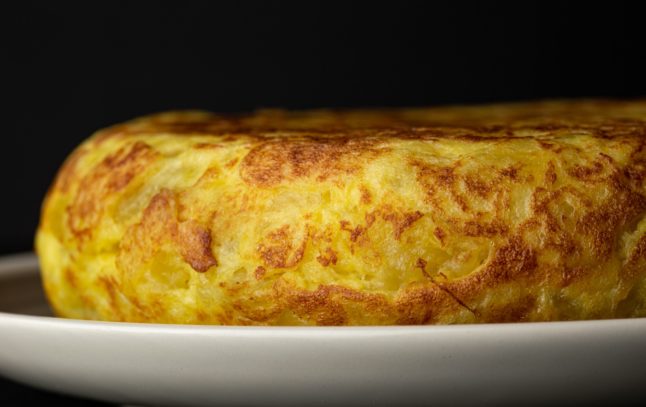Javier López Linage, a scientist from the Center for Human and Social Sciences of the Higher Council for Scientific Research (CSIC) and a potato expert believes that the origins of the Spanish tortilla can be traced back to Villanueva de la Serena in Extremadura during the 18th century.
But, the first known reference to the dish was in a letter dated 1817 addressed to the Cortes of Navarra. It said that the inhabitants of Pamplona consumed two or three eggs in an omelette with five or six potatoes.
A true Spanish tortilla should only contain just three or four ingredients – potatoes, eggs and oil and onions, depending on your preference. The question of onions (cebollas) or no onions in your tortilla seems to almost divide Spain as a nation, but The Local is firmly in the onion camp.
READ ALSO: The best vegan and vegetarian Spanish dishes
Despite the fact that making a tortilla seems relatively simple and contains very few ingredients, somehow it never turns out as good at home as it does in a bar or restaurant. It’s either too thin, too dry or too raw. Thankfully, there are a few tricks to learn so that you can make a perfect tortilla every time.
1) You’re using poor-quality ingredients
Tortillas shouldn’t be made just to use up leftover ingredients, you need them to be fresh. Eggs should be organic or free-range and you want to use only certain types of potatoes, not the kinds that break up too easily when being cooked. Francis Paniego, chef at two Michelin-Starred restaurant El Portal de Echaurren, La Rioja suggests Monalisa or Kennebec varieties that don’t mash easily.
2) You’re using the wrong type of frying pan
The correct type of frying pan is essential when making tortilla. It must be a non-stick pan so that the omelette can stay intact. In an interview with newspaper La Vanguardia Paniego warns, “Whatever the type, you must never wet the pan”. The pan must also be the correct size and fairly deep, so that the tortilla can be thick enough.
3) You’re frying the potatoes instead of poaching them
It’s common to think that you should fry your potatoes first, but a common mistake is to put the temperature up too high and fry them too much. According to the blog Recetas de Rechupete, in order to make the perfect tortilla, you want to put your stove on a low heat so that the potatoes almost poach in the oil, instead of fry. Paniego agrees, telling La Vanguardia that they should only be cooked in a little oil, not completely covered and only until tender, not crispy.
4) You’re not draining the potatoes after cooking them
You want to make sure that you drain the potatoes well after cooking so there’s not too much oil on them. Professional chefs suggest leaving them on a paper towel to soak up the oil, before using them. This way they will mix better with the eggs.

5) You’re not using the correct quantities
One of the most common errors is not using the correct amount of each ingredient. You actually need a lot more eggs than you think you do for a tortilla. Paniego suggests 300 grams of potatoes, six medium free-range eggs and 150 grams of onion, while other chefs suggest around eight eggs per kilo of potatoes.
6) You are not using the correct type of oil and you forget to add salt
Even though many cooks say not to cook with extra virgin olive oil as it shouldn’t be heated, Paniego likes to use exactly that, because of its intense flavour. Most Spanish chefs do indeed some type of olive oil for their tortillas, but Lola Cuerda, from Casa Dani in Madrid, who won an award for her Spanish omelette, uses sunflower oil instead. Salt is also an essential ingredient in tortilla. You’ll want to add a little to the potatoes while they’re cooking, and then a little more once they’re added to the egg – this helps bring out the flavour. You need the correct ratio, however, as you don’t want your tortilla too salty.
7) You’re using eggs straight from the fridge
Most people take their eggs straight out of the fridge to use in their tortillas, meaning that they’re cold, but professional chefs say you should leave them out of the fridge for a while before using them. Room-temperature eggs are less runny, which will help them mix with the potatoes better.
8) You’re pouring the egg over the potatoes in the frying pan
When the potatoes are cooked you pour the eggs over the top right? Wrong. The potatoes should be added to the beaten egg in a separate bowl and left to sit for at least ten minutes so the mixture sticks together, only then do you transfer everything back into the frying pan. According to Paniego “If we choose to put the egg directly in the pan, with the potatoes and onion already poached as a base, the egg will expand uncontrollably, the potatoes will go the other way and we will be left with a kind of broken eggs with potatoes”.
9) You’re either undercooking or overcooking it
The perfect tortilla should be neither too runny nor too solid, but of course, it will depend on personal preferences too. For example, in Galicia, it’s common for tortillas to be slightly undercooked with a very raw centre. You want to make it somewhere in between so that it’s still juicy, but not too dry. You want to cook it slowly on a low heat so that the eggs are silken and smooth.
10) You don’t know how to flip it properly
Flipping a tortilla can be the most difficult step to perfect. Some people choose to flip it with a spatula, others tip it upside down onto a plate and then there are those who throw it into the air like a pancake. You want to make sure you have enough oil on the bottom of the pan so that it easily slides around. Most professional chefs, including Paniego, believe that flipping similar to a pancake is the best method, but it takes a lot of skill.



 Please whitelist us to continue reading.
Please whitelist us to continue reading.
Member comments